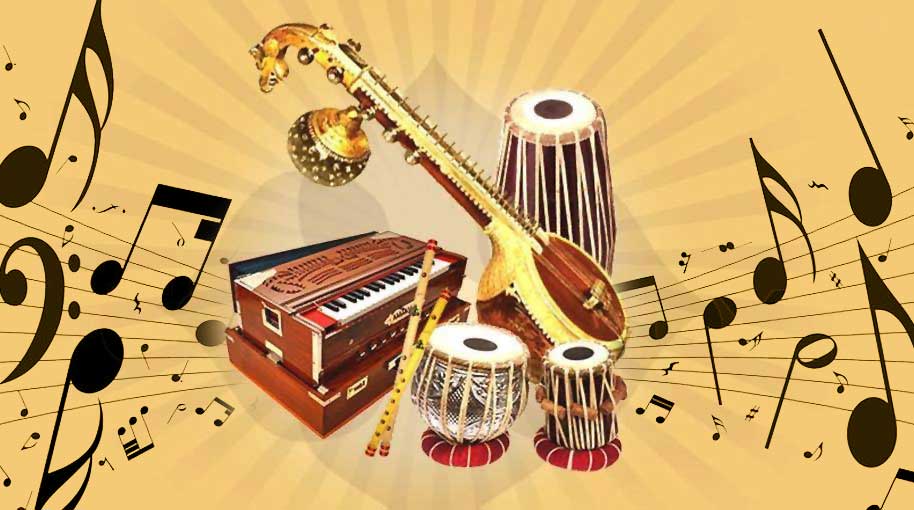Introduction
Marga, the Indian classical music, is found in the scriptures of the Hindu tradition. Samaveda, one of the four Vedas, describes music in detail. Indian music is one of the ancient musical traditions in the world. The origins of this system go back to the Vedas. Different legends have come into being regarding the roots and development of Indian classical music. Such legends delineate the importance of music in defining Indian cultural traditions. Instruments like the seven holed flute and other types of stringed instruments were found in the archaeological sites of the Indus valley.
The advent of modern historical and cultural research has given us a good perspective on the musical traditions. Indian music has been developed within a very intricate interaction between different peoples of different races and cultures. It is apparent that the ethnic diversity of present-day India has been existed from the prehistoric times.
The basis of Indian music is “sangeet“. It is a combination of three art forms: vocal music, instrumental music and dance. These three art forms were originated from the field of stagecraft. These three forms have transformed into complex and refined individual art forms.
The system of Indian music is based upon two pillars: rag and tal. Rag is the melodic form while tal is the rhythmic one. The tal are also complex. They revolve around reiterating patterns of beats.
There are two major traditions of classical music in India – the North Indian and the South Indian traditions. The North Indian tradition is called Hindustani Sangeet and the South Indian is referred as Carnatic Sangeet. Both systems are similar but differ in nomenclature and performance practice.
Hindustani Music
Khyal and Dhrupad are its two main forms of Hindustani Music. There are several other classical and semi-classical forms. There is a Persian influence in Hindustani music in terms of the instruments, style of presentation, and ragas such as Hijaz Bhairav, Bhairavi, Bahar, and Yaman. As with Carnatic music, Hindustani music has adapted different folk tunes.

Carnatic Music South Indian Carnatic music tends to be more rhythmically intensive and structured than Hindustani music. Carnatic raga elaborations are faster in tempo and shorter than its equivalents in Hindustani music. Accompanists have bigger roles in Carnatic concerts than in Hindustani concerts. Carnatic pieces have notated lyrical poems reproduced according to the performer’s ideology.

The most famous Indian musical instruments are sitar and tabla and another common instrument is the stringed tanpura. Other instruments for accompaniment include the sarangi and the harmonium.

In terms of classical musical tradition, Bangladeshi music is not different from India. In view of promoting classical music in the country, Sadaranga Uchchanga Sangeet Parishad Bangladesh was established in 1998 under the leadership of Professor Jamal Nazrul Islam. It is named after the father of kheyal, Sadaranga whose given name is Niamot Khan. Sadaranga believes association with the classical music brings peace in people’s mind while they are troubled with the complicacy of this material world. It also believes that popularity of classical music will help strengthen democracy because it helps unite people from different racial, socioeconomic and religious background. Classical music is beyond the reach of communalism. Sadaranga has taken tip the mission of making the young generation of the country enlightened through creating their affinity with the classical music. It will contribute their psycho-social development and help making them enlightened reaching beyond communalism.

Music is necessary for cultural richness. We may contribute to the development of our cultural traditions through promoting classical music entering into its mesmerizing arena. We want to create a knowledge-based society making its people enlightened. But it’s impossible to make the people enlightened without association with music. Since its inception, Sadaranga organizes yearly National Conference of Classical Music; b – monthly musical programmes; workshops on music; roundtables on related topics; documentary film exhibition, question answer sessions for awareness raising; and publishes Surshringer, a research-based journal of classical music, annually. The mission of Sadaranga is to create a harmonious society devoid of communalism. We believe everyone in the society will come forward to our assistance in the mission of creating a peaceful democratic society help making enlightened people through love and devotion to the classical music promoting its ideology of peace and harmony for everyone.
The author is the Editor, StarAvis, and freelance development consultant. You may contact him at: masud.magister@gmail.com


